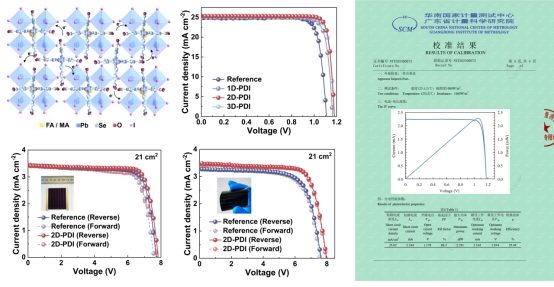Recently, the Nanophotonics Materials and Technology Team from the School of Resources, Environment, and Materials at GXU has made a significant breakthrough in perovskite solar cell research. Their findings, published in the prestigious journal Advanced Materials, are titled Dimensional Regulation of Organic N-type Dopants for Highly Efficient Perovskite Solar Cells and Modules. The lead author is Assistant Professor Liu Cong at the School, with Professors Zou Bingsuo and Liu Tao at the School, Professor Mai Yaohua with Jinan University, and Professor Hu Xiaotian with Nanchang University, serving as co-corresponding authors. The team at Guangxi University is primarily responsible for the research.
New halide semiconductor perovskite solar cells (PSCs) have grown quickly thanks to their low cost, ease of solution processing, and outstanding optoelectronic properties, bringing them closer to commercialization. Nevertheless, inverted (p-i-n) PSCs still suffer from significant open-circuit voltage (VOC) losses. These losses mainly stem from serious non‐radiative recombination on strongly polar perovskite films or at their interfaces, as well as from unbalanced charge transport due to weak n-type characteristics. In this study, the research team developed three organic small molecules with different dimensionalities based on PDI—namely 1D-PDI, 2D-PDI, and 3D-PDI—to serve as dopants in the fabrication of n-type perovskite films. The PDI molecules containing selenium (Se) show a strong ability to donate electrons, which helps to increase the quasi-Fermi level splitting (QFLS) within the perovskite and curtail rapid non‐radiative relaxation. Moreover, these molecules can form a “lattice cage” over the perovskite surface via their conjugated backbones, thus passivating bulk defects, reducing local traps, and enhancing both the n-type doping efficiency and device stability. With the incorporation of 2D-PDI, the small-area solar cell reached a power conversion efficiency (PCE) of 26.06% (with a certified efficiency of 25.44%), a VOC of 1.18 V, and an impressive fill factor of 87.23%. In addition, both rigid and flexible perovskite solar cell modules achieved PCEs of 21.48% and 20.71%, respectively (with an aperture area of 21 cm2). This finding demonstrates that the dimensional regulation approach can successfully enable n-type doping and the production of high-performance inverted perovskite solar cells, opening up new possibilities for future technological applications.

It is reported that the research received backing from projects such as NSFC, Guangxi Natural Science Foundation, and Guangxi Science and Technology Major Program. Moreover, key laboratory platforms at the national and regional levels supplied the necessary technical and resource support to ensure the research proceeded smoothly.